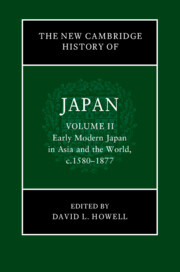Book contents
- The New Cambridge History of Japan
- The New Cambridge History of Japan
- The New Cambridge History of Japan
- Copyright page
- Contents
- Figures
- Maps
- Tables
- Contributors to Volume II
- Preface
- Frontispiece
- Introduction
- Part I The Character of the Early Modern State
- PART II Economy, Environment, and Technology
- 7 International Economy and Japan at the Dawn of the Early Modern Era
- 8 The Tokugawa Economy
- 9 The Pacific Context of Japan’s Environmental History
- 10 Scientific Communities and the Emergence of Science in Early Modern Japan
- 11 The Problem of Western Knowledge in Late Tokugawa Japan
- 12 Technology, Military Reform, and Warfare in the Tokugawa-Meiji Transition
- Part III Social Practices and Cultures of Early Modern Japan
- Index
- References
9 - The Pacific Context of Japan’s Environmental History
from PART II - Economy, Environment, and Technology
Published online by Cambridge University Press: 15 January 2024
- The New Cambridge History of Japan
- The New Cambridge History of Japan
- The New Cambridge History of Japan
- Copyright page
- Contents
- Figures
- Maps
- Tables
- Contributors to Volume II
- Preface
- Frontispiece
- Introduction
- Part I The Character of the Early Modern State
- PART II Economy, Environment, and Technology
- 7 International Economy and Japan at the Dawn of the Early Modern Era
- 8 The Tokugawa Economy
- 9 The Pacific Context of Japan’s Environmental History
- 10 Scientific Communities and the Emergence of Science in Early Modern Japan
- 11 The Problem of Western Knowledge in Late Tokugawa Japan
- 12 Technology, Military Reform, and Warfare in the Tokugawa-Meiji Transition
- Part III Social Practices and Cultures of Early Modern Japan
- Index
- References
Summary
This chapter explores Japan’s environmental history within the context of the Pacific world and its natural and human-fashioned features. Japan’s history is intertwined with the rhythms of its Pacific environment in physical and cultural ways. In this manner, the Pacific Ocean serves as a “connective force,” as one historian has described it, with far more tensile strength than the brittle cultural coherency of East Asian or Western civilization. The Pacific world provides coherency to Japanese history in ways that are often neglected but that relate to Japan’s modern industrial successes and its likely Anthropocene tragedies. By analyzing Pacific tectonics, Pacific highlands and lowlands, Pacific hydrography, Pacific climates, and Pacific politics and culture, this chapter demonstrates that the Pacific Ocean is not only a “connective force” of Japan’s history but also the energy source that powers much of it as well.
Keywords
- Type
- Chapter
- Information
- The New Cambridge History of Japan , pp. 296 - 341Publisher: Cambridge University PressPrint publication year: 2023

